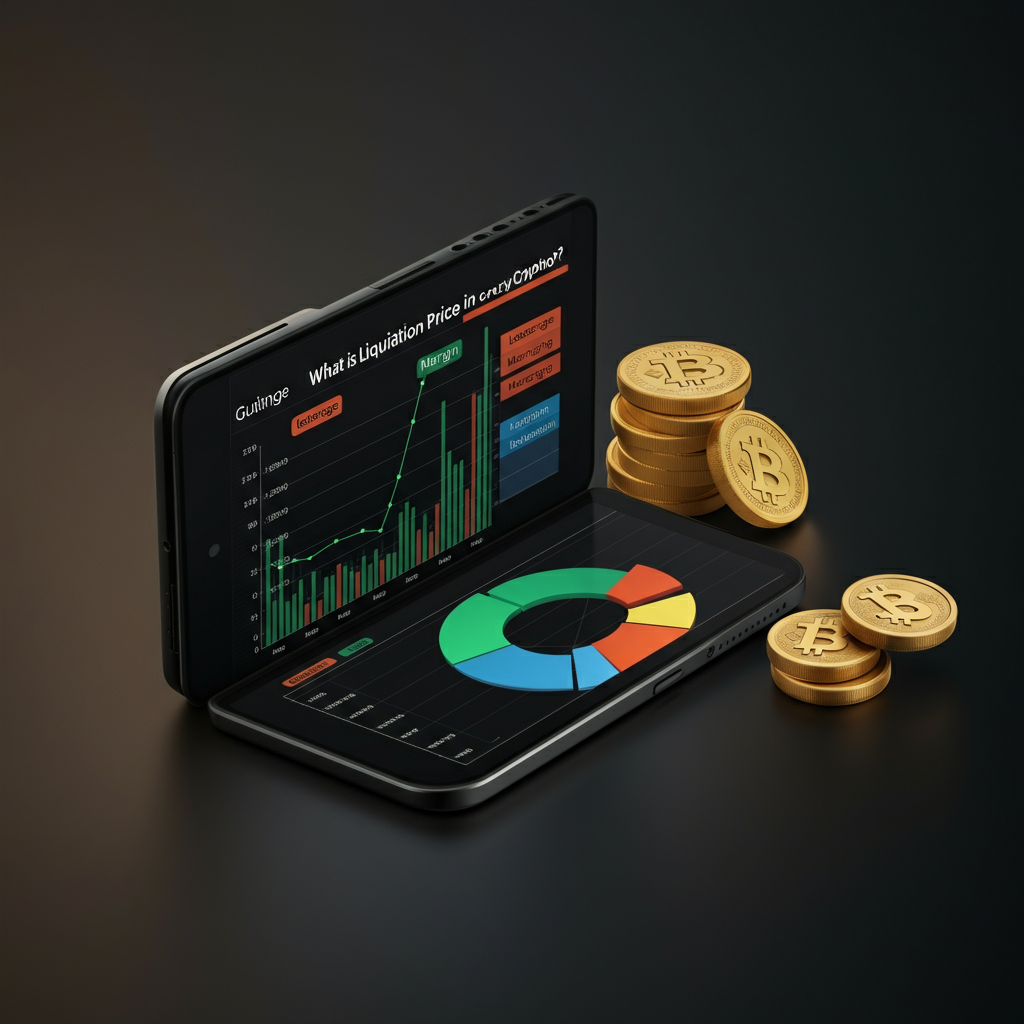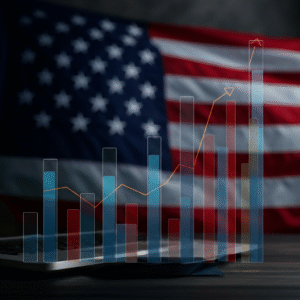Liquidation is one of the biggest risks in crypto futures trading. It’s when your open trade is automatically closed by the exchange because your losses have become too large compared to the margin you put in. This can happen within seconds — especially when you’re using high leverage on a volatile asset like Bitcoin or Solana.
In 2025, more traders than ever are entering futures markets thanks to user-friendly platforms like Binance, Bybit, and OKX. But many are doing so without understanding how liquidation works, why it happens, and how to prevent it. As a result, millions of dollars are lost daily by beginners who didn’t know they were about to get liquidated.
To avoid that, you need to understand liquidation before you enter a trade. This means knowing the role of your margin, tracking your liquidation price, and planning your risk level. The good news? Liquidation is completely avoidable if you follow smart trading practices — and it all starts with education.
What Is Liquidation in Crypto Trading?
Liquidation in crypto futures is when your position is force-closed by the exchange because your account no longer has enough margin to support the trade. The system takes over and sells your position at market price — usually with no warning, and no chance to reverse it.
This isn’t like manually closing a trade at a loss. It’s automatic, fast, and final. And the worst part? You lose your entire margin, and sometimes more (especially in cross margin mode).
Why Liquidation Price Matters in Futures
Your liquidation price is the exact price level where your trade will be closed by the system. It’s calculated based on your entry price, leverage, and available margin.
If you don’t track this price, you’re putting your position at serious risk. A small drop in market value — even 1–2% — can trigger liquidation, especially if you’re using high leverage with low margin.
Smart traders always use margin calculators and position dashboards to check their liquidation price before and after opening a trade. Knowing this number helps you set better stop-losses, manage risk, and avoid total loss.
When Does Liquidation Happen?
Liquidation happens when your trade’s losses push your margin below the maintenance requirement. Every platform has a maintenance margin level (usually 0.5%–1% of trade size). If your equity drops below that, the exchange shuts down your position to protect its funds.
This can happen faster than you expect:
-
During sudden volatility
-
Without a stop-loss
-
With tight margin or over-leverage
-
Or if funding fees eat into your margin over time
You may see warnings like “margin call” or your margin ratio hitting 100% — but if you don’t act fast, liquidation is automatic.
Who Needs to Understand This and Why?
Whether you’re a beginner or experienced trader, understanding liquidation is non-negotiable. Futures trading isn’t just about predicting price — it’s about managing risk.
-
Beginners need it to avoid early mistakes
-
Intermediate traders need it to scale up safely
-
Pros use liquidation tracking to manage multiple positions
-
Investors using bots or strategies must monitor liquidation prices on autopilot
If you’re in futures, you’re playing with leverage — and leverage without liquidation knowledge is like driving without brakes.
What Is Liquidation Price?
Liquidation price is one of the most important numbers in crypto futures trading. It tells you exactly where your position will be forcefully closed if the market moves against you. This is the point where your margin can no longer support the trade, and the exchange steps in to shut it down.
In fast-moving markets like 2025, liquidation can happen in seconds. That’s why every trader must know their liquidation price — even before clicking “Open Trade.” It’s not just a technical number; it’s your last line of defense before total loss.
Easy Definition for Beginners
Liquidation price is the exact price where your open futures position will be automatically closed by the exchange. It’s triggered when your margin balance falls below the maintenance level required to keep the trade running.
You don’t manually choose this price — the platform calculates it based on:
-
Your entry price
-
Your leverage
-
The margin you used
-
The platform’s risk formula
Once the market hits that price, your trade is closed, and you lose your margin.
The Price Level Where Your Trade Auto-Closes
Let’s say:
-
You open a BTC/USDT long at $100,000 with 10x leverage
-
You use $500 margin to open a $5,000 position
If BTC drops to $95,300, your margin can’t handle the loss anymore → your liquidation price = $95,300
The trade closes at that level automatically. You lose the $500, and your position is gone — whether you’re watching or not.
That’s why tracking your liquidation price is crucial for survival in margin trading.
Why Exchanges Use Liquidation to Protect Funds
Exchanges don’t want to take losses on your trades. When you use leverage, you’re borrowing power from the platform. If they allowed you to stay in a trade after your margin is gone, they would risk losing their own money.
So, every platform uses liquidation to:
-
Protect the borrowed funds
-
Avoid negative balances
-
Maintain system stability
Liquidation is automatic, fair, and done based on math — not emotions. That’s why exchanges like Binance, Bybit, OKX monitor it 24/7.
Liquidation Price vs Stop-Loss: What’s the Difference?
A stop-loss is a risk tool you set manually. It tells the system: “Close my trade if the market hits this price, to limit my loss.” It gives you control.
A liquidation price is not optional. It’s triggered by the system when your margin becomes too low — even if you didn’t set anything.
✅ Stop-loss = pre-planned exit
❌ Liquidation = forced exit by the platform
Smart traders always use stop-losses before their liquidation price gets hit — to protect their margin and stay in the game longer.
How Liquidation Price Is Calculated
Liquidation price tells you when your position will be force-closed by the exchange — so calculating it before entering a trade is one of the smartest things you can do. Luckily, you don’t need to be a math expert. Understanding the formula and logic behind it is enough to protect your capital.
In 2025, most platforms auto-calculate this price for you. But if you know how it’s derived, you can manage your leverage and margin far more confidently.
Formula in Simple Words
The basic idea behind liquidation price is:
Liquidation Price = Entry Price ± (Entry Price × Margin Buffer ÷ Leverage)
-
For long positions, liquidation price is below entry price
-
For short positions, liquidation price is above entry price
The “margin buffer” depends on:
-
Initial margin
-
Maintenance margin
-
Fees (like funding and taker fee)
Most platforms simplify this into an automatic number, but this formula helps you understand how the moving parts affect your risk.
What Factors Affect Liquidation Price?
Liquidation price is not fixed — it depends on the structure of your trade. The main factors are:
-
Entry price: Higher entry = higher risk in longs
-
Leverage: Higher leverage = tighter liquidation range
-
Used margin: More margin = safer buffer
-
Maintenance margin rate: Usually 0.5%–1% of trade size
-
Trading fees: Funding fees, taker fees, etc., reduce buffer
The more aggressive your setup (high leverage, low margin), the closer your liquidation price will sit to your entry.
Example with BTC/USDT and 10x Leverage
Let’s break it down with a real BTC/USDT example:
-
Entry price = $103,000
-
Leverage = 10x
-
Margin used = $500
→ You control a $5,000 trade
Now assume maintenance margin is 0.5%, and trading fees = ~$5.
Your liquidation price will be around $98,550–$98,700, depending on platform formulas. So just a 4.5%–4.8% price drop will liquidate your position.
⚠️ At higher leverage (e.g., 50x), liquidation price might be only 1.5% away.
The Role of Entry Price, Leverage, and Margin
All three work together to decide your liquidation level:
-
Entry price sets the starting point of risk
-
Leverage determines how close the risk is
-
Margin is your shield — more margin = more time before liquidation
If you increase margin or lower leverage, your liquidation price moves farther away — giving you more breathing room.
Margin and Liquidation Price Connection
Margin and liquidation price are deeply connected in futures trading — especially in 2025’s fast-moving crypto markets. The more margin you use, the safer your position becomes. The less you use, the closer your liquidation price sits to your entry. Small differences in margin can mean the difference between surviving a price swing — or getting liquidated in seconds.
Understanding this connection is the key to trading futures with confidence. Let’s break it down simply.
Lower Margin = Closer Liquidation Price
When you open a trade with low margin, the system gives you only a small buffer before your position is at risk. Even a 2–3% price drop can instantly wipe out your equity and hit your liquidation price.
Example:
-
$100 margin with 10x leverage = $1,000 trade
-
Liquidation might be just 4–5% below your entry
-
One red candle and you’re out
Adding even a little more margin — say $150 instead of $100 — pushes your liquidation price farther and gives your trade more room to recover.
High Leverage Increases Liquidation Risk
Leverage multiplies your trade size — and shrinks your buffer. A 50x leveraged trade with small margin might be liquidated after just a 1.5% price move.
The more leverage you use:
-
The less margin you need
-
The more sensitive your position becomes
-
The closer your liquidation price
Many traders mistakenly believe high leverage is the problem. It’s not. It’s high leverage with low margin that’s the killer combo.
How Initial and Maintenance Margin Play a Role
-
Initial margin is the money you use to open the position
-
Maintenance margin is the minimum you must keep to prevent liquidation
If your trade drops and your margin falls below the maintenance level, your liquidation price gets triggered. Most platforms calculate this in real-time and show your margin ratio — when it hits 100%, you’re at risk.
If you top-up your margin after entering the trade, you push the liquidation price farther, giving your position more time to breathe.
Why Small Mistakes Can Lead to Full Loss
Here’s where it gets dangerous:
You open a trade with low margin, use high leverage, forget to set a stop-loss — and a 2% move wipes out your account. No warning, no recovery.
This happens daily in crypto futures.
-
One wrong entry
-
One missed alert
-
One ignored margin ratio
→ Boom. Full liquidation.
That’s why pro traders say: “Survive first, profit later.” Margin isn’t just about entry — it’s about protecting your trade until it reaches your target.
Real Examples from 2025
Crypto markets in 2025 have been some of the most volatile yet. From meme coin pumps to Bitcoin ETF news shocks, we’ve seen thousands of liquidations — mostly caused by over-leverage and poor margin planning. Let’s break down a few real-style examples that highlight the risks and lessons.
Beginner Using 50x Leverage Loses Trade in Seconds
In April 2025, a beginner on Bybit entered a 50x long on BTC/USDT at $101,800 with only $100 margin. He was chasing a breakout just before the U.S. CPI report.
Minutes later, BTC dropped 1.8% after inflation came in slightly above forecast. His position was liquidated instantly — margin gone, trade gone. Even though BTC later recovered, it was too late for him.
⚠️ Lesson: High leverage gives no room for volatility. Small drops = instant liquidation.
5x Leverage with Strong Margin Buffer Survives
At the same time, an experienced trader opened a 5x BTC long at $102,000 using $1,000 margin on OKX. The position size was $5,000, but the large margin created a deep buffer.
BTC dropped by $1,500, but he wasn’t liquidated. His liquidation price was far below the dip. A day later, BTC bounced back above $103,000, and the trader exited with $150 profit.
✅ Lesson: Low leverage + high margin = survival during fakeouts and flash crashes.
What Happened with PEPE, BTC, and SOL Liquidations (April–May 2025)
In May 2025:
-
PEPE pumped 120%, then dumped 35% in under 4 hours
-
Over $42M liquidations hit Bybit alone — most from 25x+ leverage
-
BTC had a flash dip from $104,200 to $101,000 during ETF delays
-
SOL dropped 8% during network congestion — wiping out high-leverage longs
Most of these liquidations weren’t caused by huge price crashes — they were caused by traders being overexposed with small margins.
Many traders had $25–$50 margin on 10x–30x positions and got wiped out on small dips.
Lessons Traders Should Learn
-
High leverage is not a shortcut — it’s a risk multiplier
-
Always know your liquidation price before entering
-
Add margin to move your liquidation price farther
-
Use stop-losses and alerts before the system stops you
-
Don’t chase hype trades without planning your downside
In futures, your goal isn’t to win every trade — it’s to stay in the game. Every liquidation teaches the same thing: no plan = no funds.
How to Check Your Liquidation Price
Knowing your liquidation price before entering a trade is one of the most important safety steps in futures trading. In 2025, platforms like Binance, Bybit, and OKX have made it easier than ever to check this in real time — yet most liquidated traders still ignore it.
This section shows you exactly where to find your liquidation price, how to calculate it, and how to stay alert before it’s too late.
Where to Find It Before Entering a Trade
Before you place any order in futures:
-
Choose your trading pair (like BTC/USDT)
-
Select leverage and margin mode (cross or isolated)
-
Input your order size
The platform will then auto-calculate your liquidation price and show it on the trade preview screen. It usually appears below your entry details as:
“Estimated Liquidation Price”
If you skip this screen or don’t double-check, you’re flying blind into liquidation territory.
Tools on Binance, Bybit, and OKX
Binance Futures
-
Shows liquidation price in the “Position Preview” before trade
-
Once opened, it appears in the “Positions” tab
-
Color-coded margin ratio bar tells you risk level (green to red)
Bybit Futures
-
Clearly shows liquidation price right below your position info
-
“Risk Limit” tool lets you increase buffer for big trades
-
You can also view ADL (auto-deleverage) rank
OKX Futures
-
Uses Unified Account Mode, shows liquidation price in USD
-
Real-time updates based on funding rate, margin top-up, or price fluctuation
-
Margin health % shown live
All platforms update liquidation price automatically if you change leverage or margin.
Margin Calculator Usage Explained
Before entering a trade, use the built-in margin calculator to test your setup safely. You just need to input:
-
Entry price
-
Position size
-
Leverage
-
Cross or isolated margin mode
The calculator will show:
-
Required initial margin
-
Estimated liquidation price
-
Maintenance margin required
-
Liquidation buffer zone (in %)
✅ Pro tip: Try different leverage levels in the calculator before committing to a trade — this helps you find your safest setup.
Setting Alerts to Stay Safe
Don’t rely only on memory or visuals — set alerts for margin risk. Most platforms allow:
-
Price alerts (e.g. “alert me when BTC hits $XX”)
-
⚠️ Margin ratio alerts (e.g. “warn me when margin ratio hits 80%”)
-
Push or email alerts for liquidation danger
Using alerts gives you a warning window to:
-
Add margin
-
Reduce position size
-
Or exit manually before the system liquidates you
Surviving in futures is not about guessing direction — it’s about staying ahead of risk.
How to Avoid Liquidation
Avoiding liquidation in crypto futures isn’t about luck — it’s about discipline, planning, and tools. Most liquidations happen because traders enter without checking their risk. But if you follow a few smart rules, you can avoid losing your margin and stay in control of your trades — even in volatile markets.
Let’s break down the most effective ways to protect yourself from forced liquidation in 2025.
Use Stop-Loss Before Liquidation Hits
A stop-loss is your personal exit plan. It closes the trade before the system does, which helps you control your loss and avoid total margin wipeout.
For example:
-
If your liquidation price is $98,500
-
Set your stop-loss at $99,200
-
You lose small — and exit with control
Always place a stop-loss based on your risk tolerance, not emotions. It’s your last line of defense before liquidation takes over.
Don’t Trade with Full Wallet Balance
One of the biggest rookie mistakes is going “all in” with your futures wallet. If you trade with 100% of your capital, you have no room to add margin or survive a dip.
Instead:
-
Use 10–30% of your wallet per trade
-
Keep the rest in reserve for top-ups
-
Or hold some in spot for safety
Remember: Futures is about smart exposure — not betting everything.
Start with Low Leverage (2x to 5x)
High leverage tightens your liquidation price. That’s why beginner and mid-level traders should stick to 2x to 5x leverage until they master risk control.
With low leverage:
-
You get more margin cushion
-
Liquidation price is farther from entry
-
Your trade survives longer, even during volatility
High leverage can be tempting — but without solid planning, it’s a liquidation magnet.
Watch Funding Fees and Margin Ratio
Even if your trade is in the green, funding fees can slowly eat into your margin — especially on overnight trades. If fees keep reducing your equity, your position can liquidate even without a major price drop.
To avoid this:
-
Trade during low funding rate cycles
-
Close trades before funding time (every 8h)
-
Monitor your margin ratio — when it hits 80–90%, consider topping up or exiting
100% margin ratio = liquidation zone.
✅ Pro Tip:
Always know your liquidation price, set a stop-loss above it, use a calculator before entry, and never let a small mistake wipe out your whole trading capital.
Liquidation in Cross vs Isolated Margin
Understanding how liquidation works under isolated and cross margin modes is critical to managing risk in crypto futures. Both margin types affect your liquidation price, how much you can lose, and how much of your wallet is at risk.
Choosing the right mode depends on your skill level, capital, and strategy. Let’s compare how liquidation behaves in each and when to switch modes.
What Changes in Liquidation Price with Isolated Mode
In isolated margin, only the margin assigned to that specific position is at risk. That means your liquidation price is closer to your entry compared to cross margin — because the system can only use that one margin pool.
Example:
-
You open a $1,000 trade with $100 margin on 10x leverage
-
If price drops and your margin hits maintenance level, the trade is liquidated
-
Your wallet balance is safe, only that $100 is lost
✅ Good for risk control
❌ Liquidation price is tighter (less buffer)
Why Cross Margin Uses Full Wallet for Protection
In cross margin, your entire available wallet balance is shared across all open trades. If one position starts losing, the system pulls more funds from your wallet to extend the life of the trade.
Example:
-
You use $100 margin on a 10x trade
-
Your wallet has $500 available
→ If the trade starts losing, the system pulls from that $500 to prevent liquidation
✅ Liquidation price is farther away
❌ If not controlled, you can lose your full wallet
This mode is helpful for experienced traders with multiple positions or large balances.
Which Is Safer for Beginners?
For beginners, isolated margin is safer because:
-
Losses are limited to a single trade
-
It teaches risk control early
-
Wallet stays protected from one bad trade
Cross margin looks safer at first (because of its wider liquidation buffer), but for beginners it’s risky because one bad trade can drain the whole wallet if not monitored carefully.
✅ Isolated margin = cleaner, safer learning
⚠️ Cross margin = higher risk without discipline
When to Switch Margin Modes
Use isolated margin when:
-
You’re new to futures
-
You want to cap losses to a specific amount
-
You’re testing new strategies or short-term trades
Switch to cross margin when:
-
You have experience and confidence in risk management
-
You want to protect large trades with wallet balance
-
You’re managing multiple open positions and want flexibility
Tip: Always check your liquidation price changes when switching modes — because it moves based on your wallet size in cross, and stays fixed in isolated.
Common Mistakes That Lead to Liquidation
In 2025, crypto futures trading is more accessible than ever — but so are the mistakes that wipe out entire accounts. Most liquidations don’t happen because of bad market direction. They happen because of poor preparation, no risk control, and emotional trading.
Let’s go through the most common mistakes traders make that lead directly to liquidation — and how you can avoid them.
Trading with 50x or 100x Leverage as a Beginner
New traders often get excited seeing “100x leverage” and imagine fast profits. But what they don’t realize is that with high leverage, even a 1% move against your trade can liquidate it instantly.
Example:
-
$50 margin with 100x leverage = $5,000 position
-
BTC drops 0.8% → liquidation triggered
✅ Tip: Start with 2x–5x leverage, understand risk before scaling up.
Ignoring Margin Drop and Funding Fees
Many traders never check their margin ratio or track funding fees. Over time, especially on long trades, fees like funding, maker/taker charges, and hidden costs eat into your margin — lowering your equity even if price hasn’t moved much.
When your margin ratio hits 90–100%, you’re sitting in the danger zone.
✅ Tip: Monitor your margin ratio and funding countdowns, and avoid holding trades through high-fee periods.
No Exit Plan or Stop-Loss Set
Entering a trade without a stop-loss is like driving without brakes. One strong candle in the opposite direction — and liquidation hits before you react.
Most traders who get liquidated had no defined exit plan, no stop-loss, and no backup margin plan.
✅ Tip: Always set a stop-loss below your liquidation price and stick to a risk-reward ratio (like 1:2 or 1:3).
Blindly Following Hype Without Analysis
Social media hype (like PEPE, DOGE, or SOL pumps) can trap inexperienced traders. They jump into trades without checking technicals, margin setup, or liquidation level — and often get liquidated on the first dip.
Hype-driven entries usually lead to emotional exits — or no exit at all.
✅ Tip: Don’t copy Twitter calls. Use trading view charts, calculate your liquidation price, and set risk before you press “Buy.”
Final Reminder: Most liquidation isn’t a market problem — it’s a trader mistake. Fix your mindset and margin habits, and you’ll survive even in high-volatility markets.
Conclusion
In crypto futures trading, your liquidation price is your last warning — the final point before you lose your position and your margin. It’s not just a number on your screen; it’s the price where your control ends and the exchange takes over.
That’s why smart traders never ignore it. Before you open any trade, you should already know:
-
Where your liquidation price is
-
How much margin you’re using
-
What your stop-loss will be
-
And how far you are from auto-close risk
Most liquidations happen not because the market is unfair — but because traders entered blindly, over-leveraged, or didn’t plan for downside.
✅ Use the tools every platform gives you:
-
Margin calculator
-
Live liquidation display
-
Margin ratio tracker
-
Stop-loss and take-profit settings
-
Auto-alerts for risk levels
When you trade with a plan — not emotion — you stay in control of your capital, even in a volatile market.
Final Thought:
Leverage gives power.
Margin gives flexibility.
But only smart trading keeps your money safe.
If you respect liquidation — it will never surprise you.
FAQs: Liquidation in Crypto Futures Trading
1. What is liquidation in crypto futures trading?
Liquidation happens when your margin becomes too low to support your open position. The exchange auto-closes your trade to prevent further loss, and you lose the margin used in that trade.
2. What is a liquidation price?
Liquidation price is the exact market price where your trade will be forcefully closed by the platform. It depends on your leverage, entry price, and margin.
3. How is liquidation price calculated?
Platforms use your entry price, leverage, and margin to calculate it. Most exchanges auto-calculate it for you in the trade preview or using a margin calculator.
4. Can I change my liquidation price after opening a trade?
Yes, you can move your liquidation price by adding more margin or reducing your leverage. Topping up margin gives your trade more room to survive.
5. What’s the difference between stop-loss and liquidation?
Stop-loss is set by you — it closes your trade at a pre-defined level. Liquidation is triggered by the system when your margin falls too low, with no manual control.
6. Does high leverage increase liquidation risk?
Absolutely. Higher leverage shrinks your buffer zone, bringing your liquidation price closer to your entry. Even a 1–2% price move can wipe out your trade.
7. How do I avoid liquidation in crypto trading?
Use low leverage (2x–5x), always set a stop-loss, monitor margin ratio, and never use your full wallet on one trade. These steps give you control and safety.
8. What’s the role of margin in liquidation?
Margin is your protection. The more margin you use, the farther your liquidation price is. Small margin with high leverage is the most common reason for fast liquidation.
9. Is isolated or cross margin safer for beginners?
Isolated margin is safer for beginners because it limits losses to one trade. Cross margin uses your full wallet balance and can wipe out everything if not managed properly.
10. Why do most traders get liquidated in 2025?
Because they chase hype, use 50x+ leverage, ignore margin ratios, or skip stop-losses. Most liquidations are caused by poor risk management — not market moves.
11. What if liquidation happens — can I recover?
Once liquidation occurs, the trade is gone and the margin is lost. You can’t recover that position. But you can recover financially by learning from the mistake, adjusting your strategy, and avoiding over-leverage in the future. Many pro traders today were once liquidated early in their journey.
12. Is stop-loss better than relying on margin?
Definitely. A stop-loss allows you to exit a trade on your terms, before liquidation hits. It lets you take a smaller, controlled loss instead of losing the entire margin. Smart traders always set a stop-loss a few points above their liquidation price.
13. How can I check my liquidation price on Binance or Bybit?
On both Binance and Bybit, your estimated liquidation price is shown on the order preview screen before confirming the trade. After opening a position, you can find it in the “Positions” tab, along with your margin ratio and PnL. You can also use their margin calculators to simulate it before entry.








